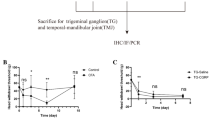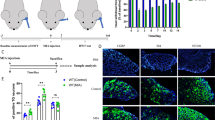Abstract
Temporomandibular disorders (TMD) comprise an assortment of clinical conditions characterized by pain in the temporomandibular joint (TMJ). TMD patients have a variety of symptoms, including jaw movement disorder and TMJ pain. Metabotropic glutamate receptor subtype 5 (mGluR5) was reported to be involved in pain processing in several animal models of neuropathic and inflammatory pain. In this study, the head withdrawal threshold and mGluR5 expression were investigated in rats with complete Freund’s adjuvant (CFA)-induced TMJ inflammatory pain. CFA injection into the TMJ significantly decreased the mechanical head withdrawal thresholds relative to vehicle injection, and the effects were blocked by pre-injection of 2-methyl-6-(phenylethynyl)-pyridine (MPEP). mGluR5 expression in the trigeminal ganglion was predominantly increased in the CFA-injected group compared with the normal control group. Pretreatment with MPEP, a selective mGluR5 antagonist, reduced mGluR5 expression in the trigeminal ganglion compared with the CFA group, as measured by immunohistochemistry, western blotting, and RT-PCR. Significant differences in the proportion or intensity of mGluR5 expression were found in animals with inflammation versus control animals at the examined time point. These findings indicate a role for peripheral mGluR5 in CFA-induced nociceptive behavior and TMJ inflammation. Peripheral application of mGluR5 antagonists could provide therapeutic benefits for inflammatory TMJ pain.





Similar content being viewed by others
References
Ahn DK, Jung CY, Lee HJ, Choi HS, Ju JS, Bae YC (2004) Peripheral glutamate receptors participate in interlenkin-1 beta induced mechanical allodynia in the orofacial area of rats. Neurosci Lett 357:203–206
Bereiter DA, Cioffi JL, Bereiter DF, Zardeneta G, Milam SB (2006) Local blockade of integrins in the temporomandibular joint region reduces Fos-positive neurons in trigeminal subnucleus caudalis of female rats produced by jaw movement. Pain 125:65–73
Bhave G, Karim F, Carlton SM et al (2001) Peripheral group I metabotropic glutamate receptors modulate nociception in mice. Nat Neurosci 4:417–423
Carlton SM, Hargett GL, Coggeshan RE (1995) Localization and activation of glutamate receptors in unmyelinated axons of rat glabrous skin. Neurosci Lett 197:25–28
Carr J, Wilhelm DL (1964) The evaluation of increased vascular permeability in the skin of guinea pigs. Aust J Exp Biol Med Sci 42:511–522
Chun YH, Ro JY (2010) Electrophysiological characterization of the rat trigeminal caudalis (Vc) neurons following intramuscular injection of capsaicin. Neurosci Lett 469:289–293
Coggeshall RE, Carlton SM (1998) Ultrastructural analysis of NMDA, AMPA, and kainite receptors on unmyelinated and myelinated axons in the peripheral. J Comp Neuro 391:78–86
Cosford ND, Tehrani L, Roppe J, Schweiger E, Smith ND, Anderson J, Bristow L, Brodkin J, Jiang X, McDonald I, Rao S, Washburn M, Varney MA (2003) 3- [(2-Methyl-1,3-thiazol-4-yl) ethynyl]-pyridine: a potent and highly selective metabotropic glutamate subtype 5 receptor antagonist with anxiolytic activity. Med Chem 46:204–207
Dogrul A, Ossipov MH, Lai J, Mala TP, Porreca F (2000) Peripheral and spinal anti-hyperalgesic activity of SIB-1757, a metabotropic glutamate receptor (mGluR5)antagonist, in experimental neuropathic pain in rats. Neurosci Lett 292:115–118
Du J, Zhou S, Coggeshall RE, Carlton SM (2003) N-methyl-d-aspartate-induced excitation and sensitization of normal and inflamed nociceptors. Neuroscience 118:547–562
Flake NM, Hermanstyne TO, Gold MS (2006) Testosterone and estrogen have opposing actions on inflammation-induced plasma etravasation in the rat temporomandibular joint. Am J Physiol Regul Inteqr Comp Physiol 291:343–348
Gasparini F, Lingenhöhl K, Stoehr N, Flor PJ, Heinrich M, Vranesic I, Biollaz M, Allgeier H, Heckendorn R, Urwyler S, Varney MA, Johnson EC, Hess SD, Rao SP, Sacaan AI, Santori EM, Veliçelebi G, Kuhn R (1999) 2-Methyl-6-(phenylethynyl)-pyridine(MPEP), a potent, selective and systemically active mGlu5 receptor antagonist. Neuropharmacology 38:1493–1503
Harriott AM, Dessem D, Gold MS (2006) Inflammation increases the excitability of masseter muscle afferents. Neuroscience 141:433–442
Hathaway CB, Hu JW, Bereiter DA (1995) Distribution of Fos-like immunoreactivity in the caudal brainstem of the rat following noxious chemical stimulation of the temporomandibular joint. J Comp Neurol 356:444–456
Hudson LJ, Bevan S, McNair K, Gentry C, Fox A, Kuhn R, Winter J (2002) Metabotropic glutamate receptor 5 upregulation in A-fibers after spinal nerve injury: 2-methyl-6-(phenylethynyl)- pyridine (MPEP) reverses the induced thermal hyperalgesia. J Neurosci 22:2660–2668
Imbe H, Ren K (1999) Orofacial deep and cutaneous tissue inflammation differentially upregulates preprodynorphin mRNA in the trigeminal and paratrigeminal nuclei of the rat. Mol Brain Res 67:87–97
Imbe H, Iwata K, Zhou QQ, Zou S, Dubner R, Ren K (2001) Orofacial deep and cutaneous tissue inflammation and trigeminal neuronal activation. Implications for persistent temporomandibular pain. Cell Tissues Organs 169:238–247
Inquimbert P, Bartels K, Babaniyi OB, Barrett LB, Tegeder I, Scholz J (2012) Peripheral nerve injury produces a sustained shift in the balance between glutamate release and uptake in the dorsal horn of the spinal cord. Pain 153:2422–2431
Lam DK, Sessle BJ, Cairns BE, Hu JW (2005) Neural mechanisms of temporomandibular joint and masticatory muscle pain: a possible role for peripheral glutamate receptor mechanisms. Pain Res Manag 10:145–152
Lawand NB, Mcnearney T, Westlund KN (2000) Amino acid release into the knee joint: key role in nociception and inflammation. Pain 86:69–74
Lee J, Ro JY (2007a) Differential regulation of glutamate receptors in trigeminal ganglia following masseter inflammation. Neurosci Lett 421:91–95
Lee JS, Ro JY (2007b) Peripheral metabotropic glutamate receptor 5 mediates mechanical hypersensitivity in craniofacial muscle via protein kinase C dependent mechanisms. Neuroscience 146:375–38
Lee HJ, Choi HS, Ju JS, Bae YC, Kim SK, Yoon YW, Ahn DK (2008) Peripheral mGluR5 antagonist attenuated craniofacial muscle pain and inflammation but not mGluR1antagonist in lightly anesthetized rats. Brain Res Bull 76:8–15
List T, Axelsson S, Leijon G (2003) Pharmacologic interventions in the treatment of temporomandibular disorders, a typical facial pain and burning mouth syndrome. A qualitative systematic review. J Orofac Pain 17:301–310
Liu MG, Matsuura S, Shinoda M, Honda K, Suzuki I, Shibuta K, Tamagawa T, Katagiri A, Kiyomoto M, Ohara K, Furukawa A, Urata K, Iwata K (2012) Metabotropic glutamate receptor 5 contributes to inflammatory tongue pain via extracellular signal-regulated kinase signaling in the trigeminal spinal subnucleus caudalis and upper cervical spinal cord. J Neuroinflammation 9:258
Lobbezoo F, Drangsholt M, Peck C, Sato H, Kopp S, Svensson P (2004) Topical review: new insights into the pathology and diagnosis of disorders of the temporomandibular joint. J Orofac Pain 18:181–191
Lynn B, Shakhanbeh J (1988) Substance P content of the skin, neurogenic inflammation and numbers of C-fibers following capsaicin application to a cutaneous nerve in the rabbit. Neuroscience 24:769–775
Miranda HF, Romero MA, Puig MM (2012) Antinociceptive and anti-exudative synergism between dexketoprofen and tramadol in a model of inflammatory pain in mice. Fundam Clin Pharmacol 26(3):373–382
Oliveira MC, Parada CA, Veiga MC, Rodrigues LR, Barros SP, Tambeli CH (2005) Evidence for the involvement of endogenous ATP and P2X receptors in TMJ pain. Eur J Pain 9:87–93
Omite K, Kawamata T, Kawamata M, Namiki A (1998) Formalin-induced release of excitatory amino acids in the skin of the rat hindpaw. Brain Res 787:161–164
Pedroni CR, De Oliveira AS, Guaratini MI (2003) Prevalence study of signs and symptoms of temporomandibular disorders in university students. J Oral Rehabil 30:283–289
Ren K (1999) An improved method for assessing mechanical allodynia in the rat. Physiol Behav 67(5):711–716
Renk R, Dubner R (1999) Inflammatory models of pain and hyperalgesia. ILAR J 40:1118–8
Roveroni RC, Parada CA, Cecolia M, Verga FA, Tambeli CH (2001) Development of a behavioral model of TMJ pain in rats: the TMJ formalin test. Pain 94:185–191
Sessle BJ (2000) Acute and chronic craniofacial pain: brain stem mechanisms of nociceptive transmission and neuroplasticity and their clinical correlates. Crit Rev Oral Biol Med 11:57–91
Sessle BJ, Hu JW (1999) Mechanisms of pain arising from articular tissues. Can J Physiol Pharmaco l69:617–626
Svensson P, Cairns BE, Wang K, Hu JW, Graven-nielsen T, Arendt-nielsen L, Sessle BJ (2003) Glutamate-evoked pain and mechanical allodynia in the human masseter muscle. Pain 101:221–227
Svensson P, Wang K, Sessle BL, Arendt-Nielsen L (2004) Associations between pain and neuromuscular activity in the human jaw and neck muscles. Pain 109:225–232
Svensson P, Wang K, Arendt-Nielsen L, Cairns BE, Sessle BJ (2005) Pain effects of glutamate injections into human jaw or neck muscles. J Orofac Pain 19:109–118
Swift JQ, Roszkowski MT, Alton T, Hargreaves KM (1998) Effect of intra-articular versus systemic anti-inflammatory drugs in a rabbit model of temporomandibular joint inflammation. J Oral Maxillofac Surg 56:1288–1295
Takeda M, Tanimoto T, Ikeda M, Nasu M, Kadoi J, Shima Y, Ohta H, Matsumoto S (2005) Temporomandibular joint potentiates the excitabilities of trigeminal root ganglion neurons innervating the facial skin in rats. J Neurophysiol 93:2723–2738
Takeda M, Tanimoto T, Ikeda M, Nasu M, Kadoi J, Yoshida S, Matsumoto S (2006) Enhanced excitability of rat trigeminal root ganglion neurons. NeuroSci 138:621–630
Takeda M, Tanimoto T, Kadoi J, Nasu M, Takahashi M, Katanga J, Matsumoto S (2007) Enhanced excitability of nociceptive trigeminal ganglion neurons by satellite glial cytokine following peripheral inflammation. Pain 129:155–166
Walker K, Bowes M, Panesar M, Davis A, Gentry C, Kesingland A, Gasparini F, Spooren W, Stoehr N, Pagano A, Flor DJ, Vranesic I, Lingenhoehl K, Johnson EC, Varney M, VrbanI KR (2001a) Metabotropic glutamate receptor subtype 5 (mGluR5) and nociceptive function I selective blockade of mGluR5 receptor in models of acute, persistent and chronic pain. Neuropharmacology 40(1):1–9
Walker K, Reeve A, Bowes M, Winter J, Wotherspoon G, Davis A, Schmid P, Gasparini F, Kuhn R, Urban L (2001b) mGluR5 receptors and nociceptive function II. mGlu5 receptors functionally expressed on peripheral sensory neurons mediate inflammatory hyperalgesia. Neuropharmacology 40:10–19
Wang S, Song L, Tan Y, Ma Y, Tian Y, Jin X, Lim G, Zhang S, Chen L, Mao J (2012) A functional relationship between trigeminal astroglial activation and NR1 expression in a rat model of temporomandibular joint inflammation. Pain Med 13:1590–1600
Wheeler-Aceto H, Cowan A (1993) Naloxone causes apparent antinociception and pronociception simultaneously in the rat pain formalin test. Eur J Pharmaco l236:193–199
Xin S, Urban MO (2005) Effect of metabotropic glutamate receptor subtype 5 antagonist, 2-methyl-6-(phenylethynyl)-pyridine on mechanosensory afferents innervating rat hind paw following inflammation. Neurosci Lett 390:123–128
Yamazaki Y, Ren K, Shimada M, Iwata K (2008) Modulation of paratrigeminal nociceptive neurons following temporomandibular joint inflammation in rats. Exp Neurol 214:209–218
Young MR, Fleetwood-Walker SM, Mitchell R, Munro FE (1994) Evidence for a role of metabotropic glutamate receptors in sustained nociceptive inputs to rat dorsal horn neurons. Neuropharmacology 33:141–144
Yu XM, Sessle BJ, Vernon H, Hu JW (1995) Effects of inflammatory irritant application to the rat temporomandibular joint on jaw and neck muscle activity. Pain 60:143–149
Yu XM, Sessle BJ, Haas DA, Izzo A, Vernon H, Hu JW (1996) Involvement of NMDA receptor mechanisms in jaw electromyographic activity and plasma extravasation induced by inflammatory irritant application to temporomandibular joint region of rats. Pain 68:169–178
Zammataro M, Chiechio S, Montana MC, Traficante A, Copani A, Nicoletti F, Gereau RW (2011) mGlu2 metabotropic glutamate receptor restrain inflammatory pain and mediate the analgesic activity of dual mGlu2/mGlu3 receptor agonists. Mol Pain 7:3–5
Zhu CZ, Hsieh G, Ei-Kouhen O, Wilson SG, Mikusa JP, Hollingsworth PR, Chang R, Moreland RB, Brioni J, Decker MW, Honore P (2005) Role of central and peripheral mGlu5 receptors in post-operative pain in rats. Pain 114:195–202
Acknowledgments
This research was supported by a grant from the Foundation of Science and Technology Commission of Liaoning (no. 2009A779) and Science Foundation of Liaoning (no. 2010201003). The authors would like to thank all the anonymous reviewers for their valuable comments on how to improve the quality of this paper.
Author information
Authors and Affiliations
Corresponding author
Rights and permissions
About this article
Cite this article
Li, B., Lu, L., Tan, X. et al. Peripheral Metabotropic Glutamate Receptor Subtype 5 Contributes to Inflammation-Induced Hypersensitivity of the Rat Temporomandibular Joint. J Mol Neurosci 51, 710–718 (2013). https://doi.org/10.1007/s12031-013-0052-2
Received:
Accepted:
Published:
Issue Date:
DOI: https://doi.org/10.1007/s12031-013-0052-2




